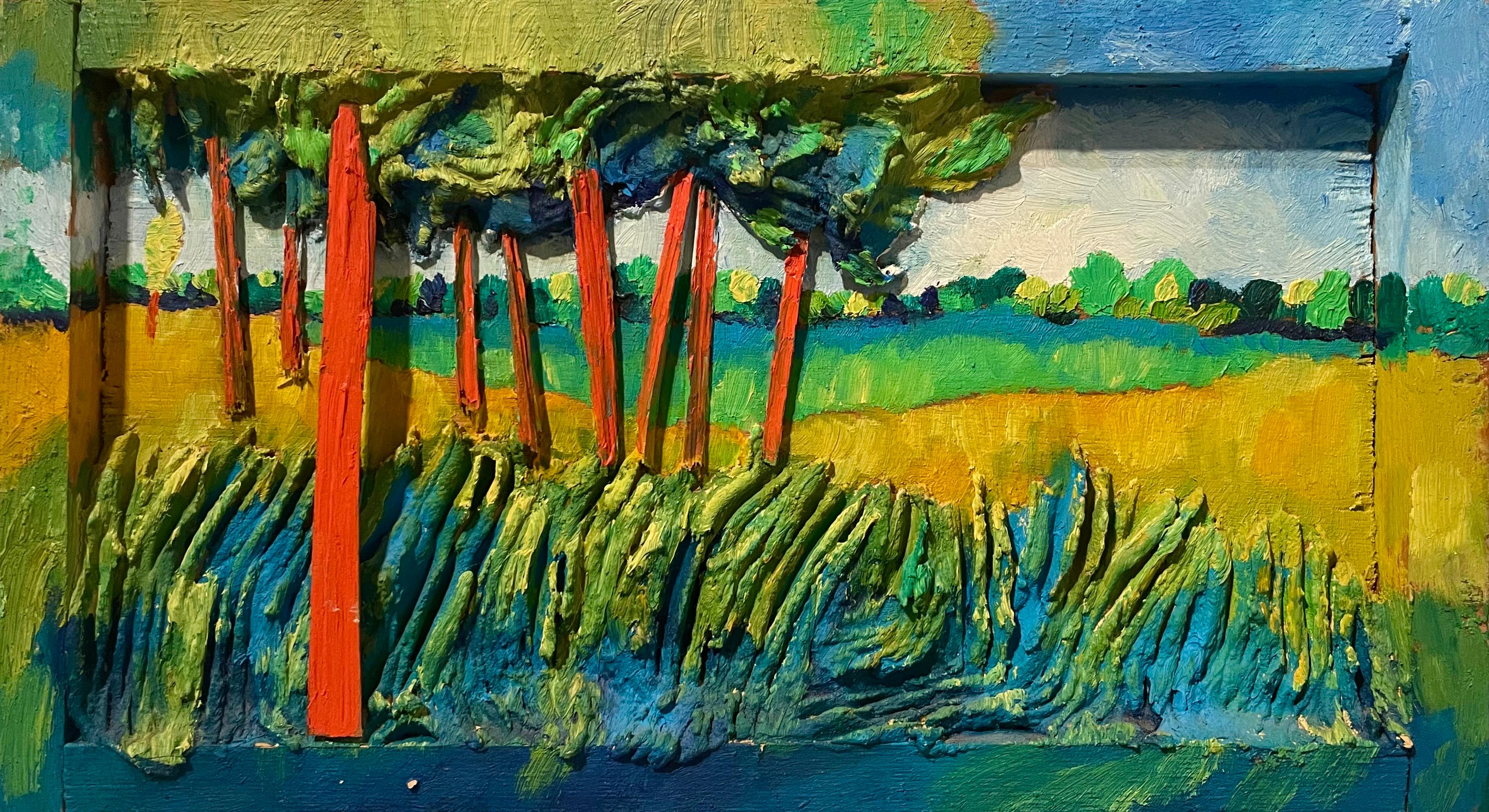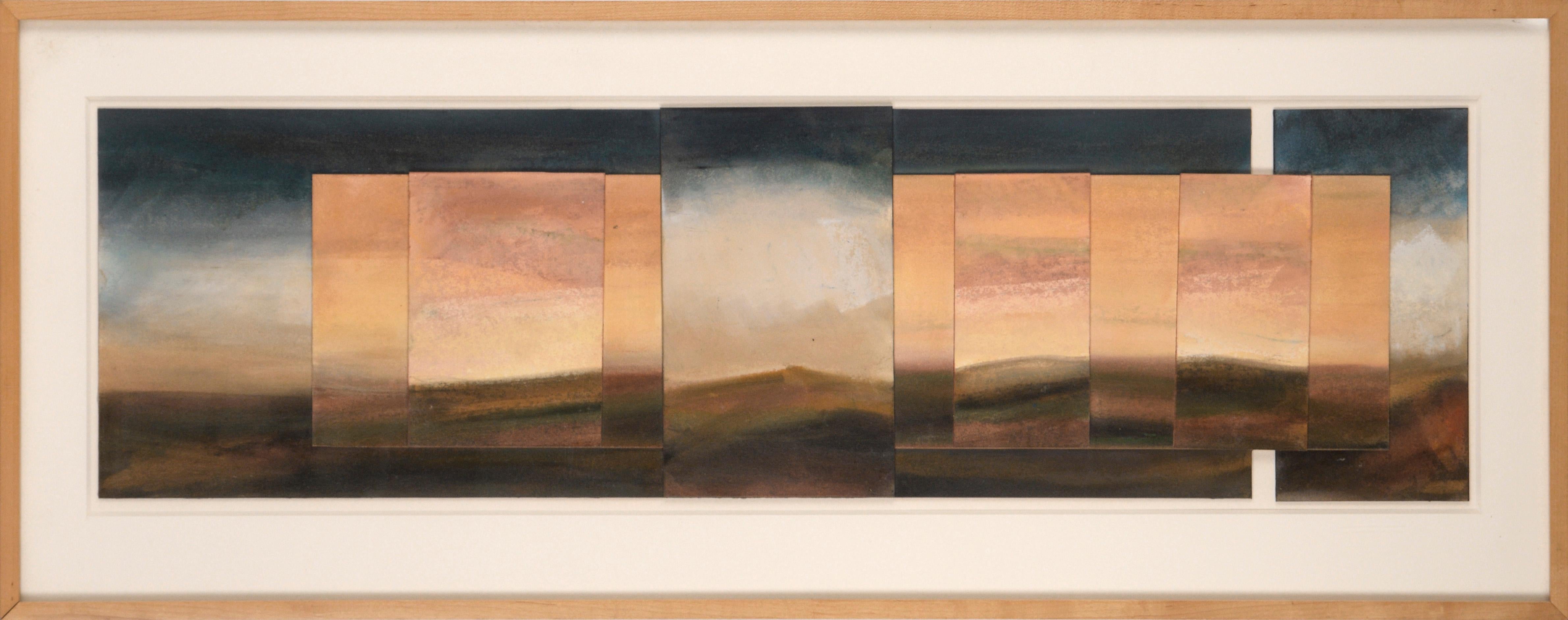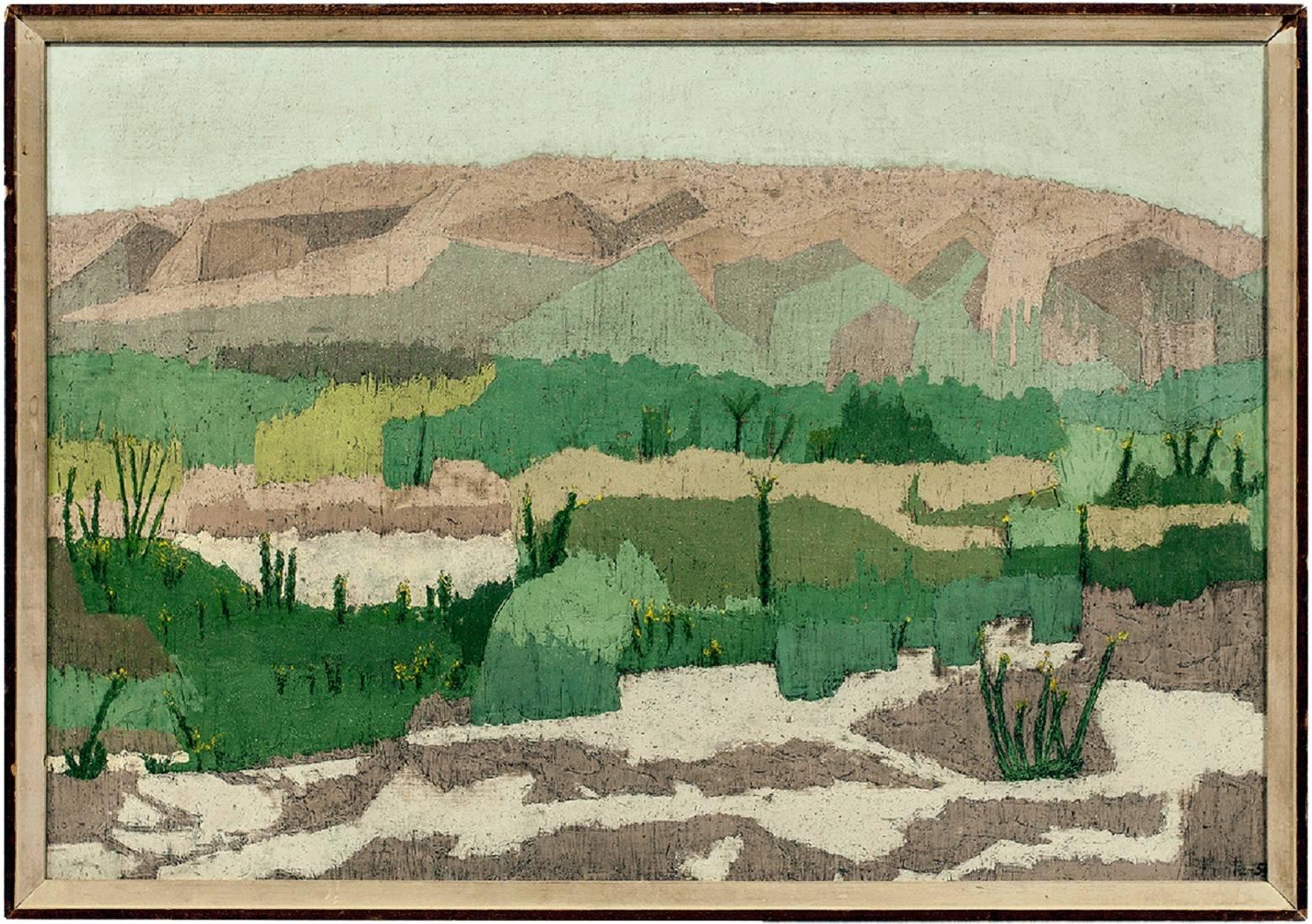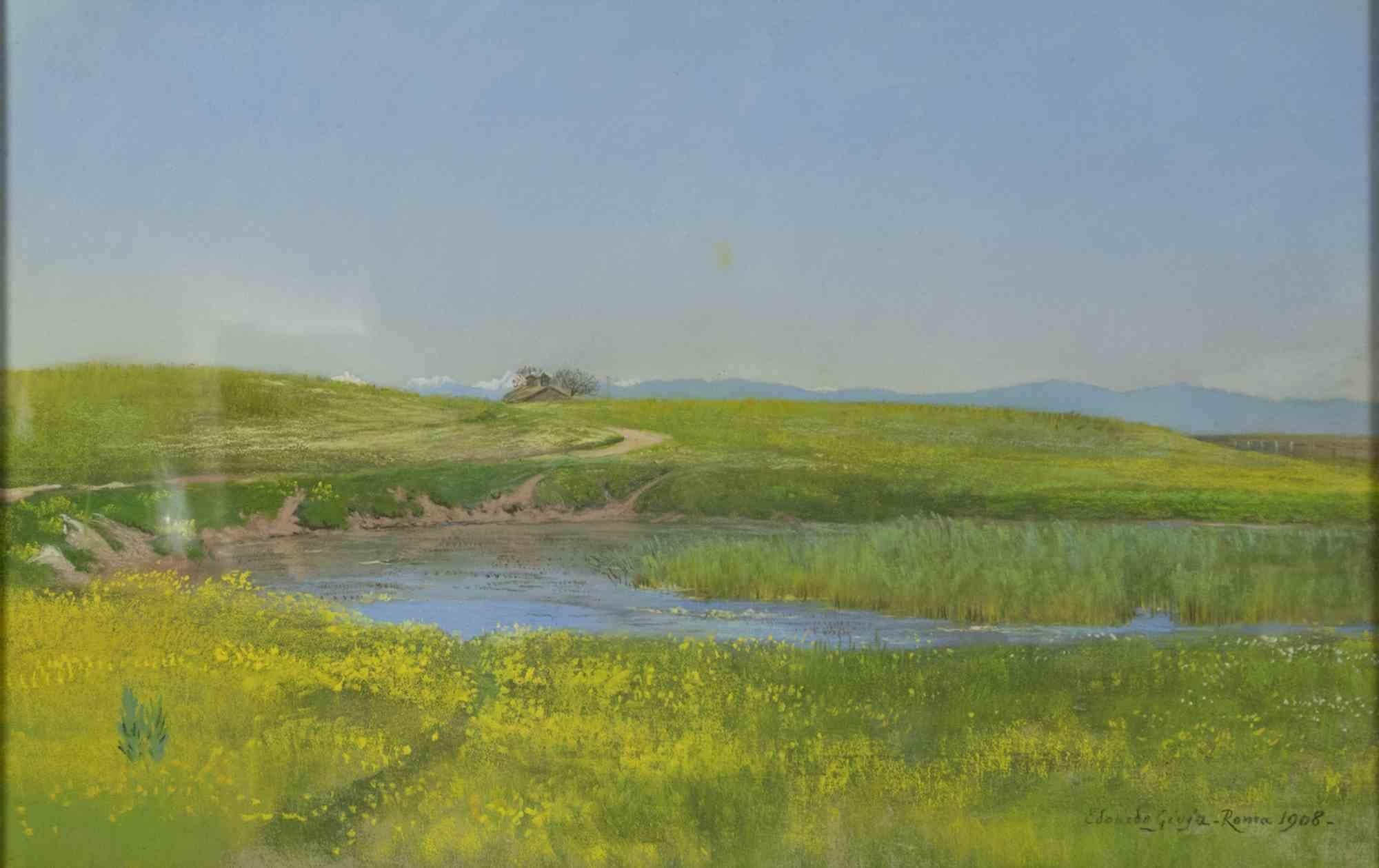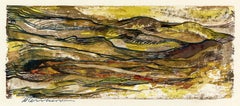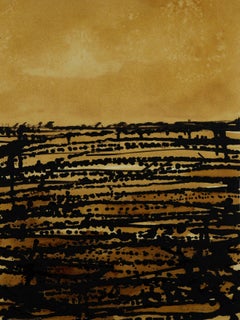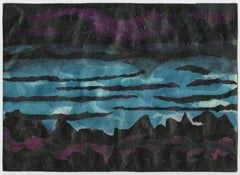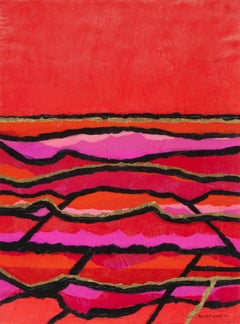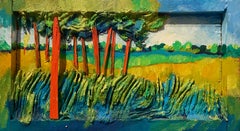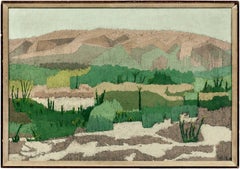Items Similar to Untitled (Tuscan Landscape)
Want more images or videos?
Request additional images or videos from the seller
1 of 5
Ray H. FrenchUntitled (Tuscan Landscape)1964
1964
$3,000
£2,313.44
€2,638.02
CA$4,278.62
A$4,676.04
CHF 2,460.68
MX$56,007.34
NOK 30,970.13
SEK 28,924.89
DKK 19,703.58
About the Item
Untitled (Tuscan Landscape)
Tissue paper collage on Fabriano support
Signed and dated lower right in ink
Provenance:
Estate of the artist
Martha A. French Trust
Created while the artist lived in Florence, Italy.
Condition: Excellent
Image/Sheet size: 10 x 13 7/8 inches
From Wikipedia
Ray H. French (May 16, 1919 – April 21, 2000) was an American printmaker, painter, sculptor and artistic innovator. He attended the John Herron School of Art and received his Bachelors and Masters of Fine Arts at the University of Iowa under professor and artist Mauricio Lasansky. While French studied, traveled, and exhibited nationally and internationally, he remained dedicated to his home state of Indiana, which served as a strong artistic inspiration to him. In addition to his artistic career, French was also on the faculty of DePauw University from 1948 to 1984. Following his retirement from university service, French continued to create artwork in his private studio until his death in Greencastle, Indiana.
Early life
Born in Terre Haute, Indiana on May 16, 1919 to parents Edgar and Radie Mae, French demonstrated his artistic abilities from an early age. For a youth with humble beginnings, art was a luxurious, even rebellious, aspiration. As a child, French was first exposed to art by Mabel Mikel Williams who taught both in Vigo County elementary schools and also private students. His interests grew as he was encouraged further at Woodrow Wilson Jr. High School by art teacher Nola E. Williams.
Education
After high school, French attended the Indiana University John Herron School of Art on scholarship. During World War II, he enlisted in the Army Air Force and was stationed in Colorado developing reconnaissance photos. While in Colorado, he had the opportunity to study watercolor with Adolf Dehn at the University of Colorado.
Following World War II, French returned to John Herron School of Art on the G.I. Bill and then transferred to the University of Iowa, where he obtained his BFA in 1947 and MFA in 1948. In Iowa, French evolved under the mentorship of celebrated printmaker Mauricio Lasansky who had established one of the first printmaking MFA programs in the country. French's 1949 engraving entitled Porcupine is indicative of this training and was exhibited at the Museum of Modern Art in 1949.
Always striving to improve his craft, French continued his education at the Accademia di Belle Arti in Florence, Italy and the Hobart School of Welding Technology in the 1960s.
Career
French was an accomplished artist who excelled in creating engravings, etchings, embossings, graphic constructions, watercolors, pastels, and metal and Plexiglas sculptures. French's 1959 etching Enchantment remains particularly illustrative of his characteristic use of etching and soft ground intaglio. Enchantment was exhibited at the Brooklyn Museum of Art in 1960 and received the Pennell Purchase Prize from the Library of Congress the same year.
Throughout this artistic career, French was also Professor of Art at DePauw University 1948-84 where he taught printmaking and art history and was head of the art department 1970-1978. From 1963-64 he and his family lived in Florence, Italy while he attended classes at the Accademia di Belle Arti. He was also Curator of the University Art Collection 1978-1984. In 1980, French opened the Center Street Gallery behind his home near the DePauw campus where he continued his work following his retirement in 1984.
Legacy
French exhibited in national exhibitions since 1944 including 86 one-man exhibitions in the United States and Italy.
His work is in over 500 collections including The Museum of Modern Art, the Library of Congress, Metropolitan Museum of Art, the Smithsonian American Art Museum, the Victoria and Albert Museum, the Bibliothèque Nationale, the Brooklyn Museum, the Philadelphia Museum of Art, the Denver Art Museum, the New York Public Library, the Boston Public Library, Midwest Museum of American Art, the Minneapolis Institute of Art, and the Syracuse University Art Galleries.
Over his lifetime, French also received many grants and honors including over 58 prizes and purchase awards. Specifically, French was awarded an Eli Lily Grant for an extensive tour in Europe in 1961 and received a Ford Foundation Grant in 1969 to develop a new medium in printmaking known as graphic construction.
French and his family were also avid art collectors whose collection now comprises 5 percent of the permanent collection of the Swope Art Museum in the artist's hometown of Terre Haute, Indiana. His granddaughter Adrienne French is a fine art photographer.
References
• "Ray H. French Fine Art Scholarship". Retrieved 2012-10-03.
• "Swope to open exhibit of French family donations". Retrieved 2012-10-03.
• "DePauw duplexes named in honor of past legends". Retrieved 2012-10-03.
• Beall, Karen F. (1970). American Prints in the Library of Congress: A Catalog of the Collection. pp. 160.
- Creator:Ray H. French (1919-2000, American)
- Creation Year:1964
- Dimensions:Height: 10 in (25.4 cm)Width: 13.88 in (35.26 cm)
- Medium:
- Movement & Style:
- Period:
- Condition:
- Gallery Location:Fairlawn, OH
- Reference Number:Seller: FA100401stDibs: LU14013763802
About the Seller
5.0
Recognized Seller
These prestigious sellers are industry leaders and represent the highest echelon for item quality and design.
Gold Seller
Premium sellers maintaining a 4.3+ rating and 24-hour response times
Established in 1978
1stDibs seller since 2013
828 sales on 1stDibs
Typical response time: <1 hour
Associations
International Fine Print Dealers Association
- ShippingRetrieving quote...Shipping from: Fairlawn, OH
- Return Policy
More From This Seller
View AllMountainous Landscape, Mexico
Located in Fairlawn, OH
Mountainous Landscape, Mexico
Monotype in colors on heavy paper, c. 1960's
Signed in ink lower left "G Ceniceros"
Condition: Excellent
Image size: 6 x 14 1/2" (15.24 x 36.83cm)
Sheet size: 12 7/8 x 19 11/16 inches
Guillermo Ceniceros (born May 7, 1939) is a Mexican painter and muralist, best known for his mural work in Mexico City, as well as his figurative easel work. He began his mural painting career as an assistant to mural painters such as Federico Cantú, Luis Covarrubias and then David Alfaro Siqueiros who was a mentor and a key influence. Ceniceros is the most notable of Siqueiros' assistants. While he has experimented with abstract expression, his easel work mostly classifies as figurativism and is influenced by the geometrical construct of Mexican muralism. He has had over 300 individual and collective exhibitions in Mexico and the International stage. His work has been recognized by the Mexican Ministry of Culture and several of its institutions. He has painted over 20 large scale Mural Paintings with some of the most notable being the large scale work for the Legislative Palace of San Lazaro (Mexico's Legislative Building) as well as his murals in the Metro Subway System. He is a member of the Salón de la Plástica Mexicana. In 1995, the State of Durango, Ceniceros' native state, opened to the public the Guillermo Ceniceros Art Museum within the oversight of the Ministry of Culture. Ceniceros has been reviewed by notable critics such as Berta Taracena, Raquel Tibol, Alaide Foppa, Graciela Kartofel, José Angel Leyva and Eduardo Blackaller among others. There are several publications about his work including a vast review of his art life endeavors developed by the Ministries of Culture of Durango and Nuevo León. He is married to the artist Esther González and lives in his studio house in the Colonia Roma of Mexico City.
Life
Interview with the subject Ceniceros and Siqueiros
Ceniceros was born in a small village called El Salto, located in the municipality of Pueblo Nuevo in the Mexican state of Durango. His father was a woodworker who made toys and furniture in his workshop. His father's shop would become an influence in Ceniceros' life long interest in developing his own innovative working tools. When he was twelve the family moved to Monterrey to seek better economic opportunities. There he attended school and when he was fourteen he entered the Fabricación de Máquinas, S.A. (FAMA), a school/business, where he studied industrial drawing. He considers this early training important as it taught him the importance of geometry, use of space and materials. While at FAMA he met painters Gerardo Cantú and Ignacio Ortiz, and collaborated with them on sketches for publications of Alfonso Reyes, Pedro Garfias and other notable writers.
In 1955, he enrolled in the Taller de Artes Plásticas at the Universidad Autónoma de Nuevo León, graduating in 1958. At the Taller he met fellow Mexican artist Esther González, whom he married and with whom he has two children.
In 1962 he moved to Mexico City with the goal of working in the Taller of the Maestro David Alfaro Siqueiros. He became Siqueiros' first assistant working on his last murals while at the same time working at night on his easel painting work. Siqueiros supported Ceniceros decision to leave his Taller and supported him in his career until his death in 1974. By then Ceniceros was already a break thru artist having had several individual exhibitions including the prestigious Palacio De Bellas Artes as well as other recognitions. Thru the 70's and 80s Ceniceros continued his work with an emphasis on exhibits and exchanges abroad and traveling to Eastern Europe, Cuba, China, Chile, Ecuador, Italy and the United States. His Mexico City contemporaries and circle would include names that today have become reference such as Sebastian, José Luis Cuevas, Gilberto Aceves Navarro, Benjamin Dominguez, Gustavo Arias Murueta, Byron Galvez, Leonel Maciel among others. In the 70's his Row-House neighbors in the colonia Roma were Francisco Toledo and Alejandro Jodorowski.
His focus on mural painting is renewed in the mid 80's thru his large scale work in the Metro Subway System with him working on major commissions consistently and into the new century. While the Mexican school of Muralism had been challenged by the Ruptura members, the interest in Mural painting as a unique national form of expression continues.
He lives in Mexico City at a studio/home in the Colonia Roma. His home is a frequent gathering place for writers, poets, painters, singers, actors and journalists. He has a strong interest in Spanish language literature. Juan Rulfo...
Category
1960s Modern Landscape Drawings and Watercolors
Materials
Monotype
Untitled
By Ray H. French
Located in Fairlawn, OH
Signed and dated "1962" by the artist lower right.
Mixed media on heavy paper.
Done for a show to fund a trip to Italy.
Category
1960s Abstract Abstract Drawings and Watercolors
Materials
Ink, Mixed Media
Untitled (Seascape at night)
By Ray H. French
Located in Fairlawn, OH
Untitled (Seascape at night)
Tissue paper collage on Fabriano wove paper, 1964
Signed in ink lower left
Annotated 42 in pencil on verso
Condition: Excellent
Image/Sheet size: 10 x 13 7/8 inches
Part of a suite of collages created during the artist's sabatical leave from teaching, spent in Florence, Italy, studying at the Accademia D'Arte Firenze in 1963-1964.
Ray H. French: The Evolution of an Artistic Innovator
Printmaker, painter, and sculptor Ray H. French was born in Terre Haute, Indiana on May 16, 1919. Terre Haute was a cultural wasteland before the opening of the Sheldon Swope Art Museum in 1942. Thus, with a father as a coal miner and carpenter, art remained a luxury for Ray. Nevertheless, local art teachers Mabel Mikel Williams and Nola E. Williams helped to foster his creativity and unshakable drive to create things of beauty.
After high school, Ray attended the John Herron School of Art in Indianapolis. His studies there were interrupted by the outbreak of World War II, during which he developed surveillance photographs for the Army Air Force. After the war, Ray transferred to the University of Iowa on the G.I. Bill, where he received both his BFA and MFA degrees. The University of Iowa during the 1940s was a cultural mecca with many major art historians and artists. While in Iowa, Ray played an important role in this culture by becoming a founding member of the Iowa Print Group under Mauricio Lasansky.
Following his graduation in 1948, Ray experienced firsthand the rapid rise in creative printmaking in America. By 1949, he had exhibited at The Brooklyn Museum, the Walker Art Center, and MOMA New York. Ray’s early style of printmaking is characterized by pure line engraving on copper plates, a technique suited perfectly to his study of the beauty of animals. This charming and whimsical subject ran counter to the concurrent trends of Lasansky’s horrors of war and Hayter’s non-objectivity, but was equally effective in capturing the public’s attention. Walruses was purchased by the Victoria and Albert Museum, exhibited at MOMA New York and received the Arthur D. Allen Memorial Purchase Prize for its “skillful and economic use of line.” Shortly thereafter, Ray’s treatment of animals developed further into larger format mixed intaglio prints utilizing hard ground, soft ground, etching, and engraving, as exemplified in The Swan.
By the late 1950s, Ray’s style evolved into organic non-objectivity, in which he incorporated personal autobiographical vignettes and symbolism. His work during this time was further characterized by a departure from the traditional squared compositional format to his cutting and rounding of the plate to accentuate organic shapes. Ray’s 1959 Enchantment remains particularly illustrative of his use of etching and soft ground intaglio. Enchantment was successfully exhibited at the Brooklyn Museum of Art for the 12th National Print Exhibition of The American Federation of the Arts and received the Pennell Purchase Prize from the Library of Congress in 1960.
In the 1960s, Ray also started to focus on blind embossing, which he had first experimented with at the University of Iowa. He was extremely prolific and successful with this medium, selling hundreds of prints in small editions of 10 through the Associated American Artist Gallery in New York. In 1966, Ray built upon his mastery of embossing and began developing a shadow box presentation called a graphic construction that combined color, blind embossing, and multi-layered cutouts to revel intaglio compositions. Noted curator William Lieberman purchased Ray’s masterpiece graphic construction, Moon Rays...
Category
1960s American Modern Mixed Media
Materials
Tissue Paper
Seascape at Sunset
By Ray H. French
Located in Fairlawn, OH
Seascape at Sunset
Collage with tissue paper and gold foil on Fabriano paper, 1964
Signed and dated in ink, lower right (see photo)
Provenance:
Estate of the artist
Martha A. French...
Category
1960s Mixed Media
Materials
Mixed Media
Untitled
By Ray H. French
Located in Fairlawn, OH
Signed and dated lower left
Created in 1964 while the artist was living in Florence, Italy
Collage with tissue paper and printed images and text
From the Estate of the Artist
Category
1960s Abstract Expressionist Mixed Media
Materials
Mixed Media
untitled (Hillside in Spring)
By William C. Grauer
Located in Fairlawn, OH
untitled (Hillside in Spring)
Gouache on paper, c. 1965
Signed with the estate stamp lower right
Provenance: Estate of the artist
by decent
William C. Grauer (1895-1985) was born in Philadelphia to German immigrant parents. After attending the Philadelphia Museum School of Industrial Art, Grauer received a four year scholarship from the City of Philadelphia to pursue post graduate work. It was during this time that Grauer began working as a designer at the Decorative Stained Glass Co. in Philadelphia.
Following his World War I service in France, Grauer moved to Akron, Ohio where he opened a studio in 1919 with his future brother-in-law, the architect George Evans...
Category
1960s Realist Landscape Drawings and Watercolors
Materials
Gouache
You May Also Like
Untitled (Landscape)
Located in New York, NY
This three-dimensional painting by Russell Sharon is on view in the 50th Anniversary exhibition, 50: The View from Tribeca.
Russell first exhibited at Hal Bromm in 1983. His works r...
Category
1980s Mixed Media
Materials
Mixed Media, Oil, Wood Panel
Tuscany Landscape Panel #409
Located in Soquel, CA
Abstracted landscape by Derrik Van Nimwegen (American, b. 1969). Moody and expressive, the "background" landscape captures the feel of winter with ...
Category
1980s American Impressionist Landscape Paintings
Materials
Oil, Board
$4,200 Sale Price
20% Off
Abstract Landscape 1954 American Modernist from Paul Rosenberg Gallery
By Raymond Mintz
Located in Surfside, FL
Label verso from Paul Rosenberg Gallery. (this was 600$ in 1954!) 18 X 26 without frame. 19 X 27.75 with frame
Raymond was born in Clifton, New Jersey, in 1925, of German descent.
...
Category
Mid-20th Century Modern Landscape Paintings
Materials
Oil, Board
Vintage Modernist Landscape of the Tuscan Countryside
Located in Douglas Manor, NY
6145 Tuscan landscape painting on artist board
Set in a vintage ornate wood frame
Image size 10.5x9"
Category
1980s Landscape Paintings
Materials
Oil
$300 Sale Price
36% Off
Untitled (Brown Landscape), landscape, bold colors
Located in New York, NY
Oil painting of a landscape with painterly, expressive brush strokes representing trees are blowing in the wind.
Russell Sharon was born on a farm in Minnesota. He studied in Mexico City, Boston and New York. He is known for his wildly colorful works with imagery drawn from the Minnesota landscape...
Category
1980s Neo-Expressionist Landscape Paintings
Materials
Canvas, Oil
Roman Countryside - Mixed Media by E. Gioja - 1908
By Edoardo Gioja
Located in Roma, IT
Roman Countryside is a modern artwork realized in 1908 by Edoardo Gioja.
Mixed media on wood panel. Hand signed and dated on the lower right margin.
Includes frame.
Edoardo Gioja (Rome, 1862 - Rome, 1937), an Italian painter and artist. He treated the decoration and portrait with Pre-Raphaelite taste. Influenced by Nino Costa, he repudiated genre painting by reproducing marines, countries, plants, animals and painted and drew with simplicity and with very effective results. He decorated several rooms in London and prepared cartoons for stained glass...
Category
Early 1900s Modern Landscape Paintings
Materials
Tempera, Wood Panel
